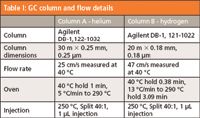The Benefits of Switching from Helium to Hydrogen as a Carrier Gas
Special Issues
Proton OnSite
John Speranza, Proton OnSite
The most common carrier gas used for gas chromatography (GC) in the US is helium. But due to dwindling supplies, costs are rising. In this note we discuss why chromatographers may choose to switch to hydrogen, a gas easily and inexpensively produced safely through an on-site generator via electrolysis.
Helium has always been a prized resource, sealed in caverns filled with the gas to create the Helium National Reserves. But in 1996, legislation (1) allowed the sale of 0.6 billion ft3 of gas between 2005 and 2015. The law also set the price of crude helium to approximately $43/1000 scf. In 2010 the Federal Bureau of Land Management reset prices to $64.75/1000 scf, based on the Consumer Price Index (2). This increased to $75.75/1000 scf for FY 2012. Critics argue this price is still too low when assessing remaining reserves of helium (3).
In addition to the economic issues around using helium in GC, there is a question of efficiency. Both helium and hydrogen are very efficient gases to use for GC. But the differences in the properties of the gases will lead to a difference in the efficiency of the separation. Using the van Deemter equation, which predicts an optimum velocity at which there will be the minimum variance per unit column length and, hence, a maximum efficiency (4), one can deduce that linear flow rate of hydrogen can be greater than that of helium and offer equal efficiency in the gas's ability to separate peaks.
Experiment
This application note is a comparison of similar-sized columns; one of helium and one of hydrogen is presented (5). Spearmint oil is separated using both a helium carrier and a hydrogen carrier (Table I).

Table I: GC column and flow details
Results
Using hydrogen as a carrier gas in conjunction with the high efficiency column resulted in an overall speed gain of 61% compared to the original method (Figure 1).

Figure 1: The separation of spearmint oil, obtained using the conditions outlined in Table I. The first separation, (a), used a helium carrier gas and obtained results between 8 and 28 min to separate. The second separation, (b), used hydrogen carrier gas and obtained comparable resolutions between 3 and 11 min.
Conclusions
Hydrogen can be produced safely on-site compared to helium, which occurs rarely and is a finite resource. It should be noted that the use of stored, cooled, or pressurized hydrogen can bring with it fire and explosion (6).
Also, using the van Deemter curve, it is apparent that using hydrogen as a carrier gas instead of helium will allow an increased flow rate without effecting the efficiency of the separation, thus increasing the throughput of a laboratory.
References
(1) The Helium Privatization Act, P.L. 104–273 (1996).
(2) Bureau of Land Management, 2012.
(3) R. Richardson, New Scientist 2273, 19 (2010).
(4) J.J. van Deemter, F.J. Zuiderweg, and A. Klinkenberg, Chem. Eng. Sc. 5, 271–289 (1956).
(5) Agilent Technologies Inc. "Food, Flavor and Fragrance Applications" Agilent J&W GC Column Selection Guide, 250, www.agilent.com/chem/myGCcolumns, (2012).
(6) International Organization of Standardization, Basic Considerations for the Safety of Hydrogen Systems, ISO/TR 15916, 2004(E).
Proton OnSite
10 Technology Drive, Wallingford, CT 06492
tel. (203) 678-2000
Website: www.protononsite.com

Thermo Fisher Scientists Highlight the Latest Advances in Process Monitoring with Raman Spectroscopy
April 1st 2025In this exclusive Spectroscopy interview, John Richmond and Tom Dearing of Thermo Fisher Scientific discuss the company’s Raman technology and the latest trends for process monitoring across various applications.
A Seamless Trace Elemental Analysis Prescription for Quality Pharmaceuticals
March 31st 2025Quality assurance and quality control (QA/QC) are essential in pharmaceutical manufacturing to ensure compliance with standards like United States Pharmacopoeia <232> and ICH Q3D, as well as FDA regulations. Reliable and user-friendly testing solutions help QA/QC labs deliver precise trace elemental analyses while meeting throughput demands and data security requirements.